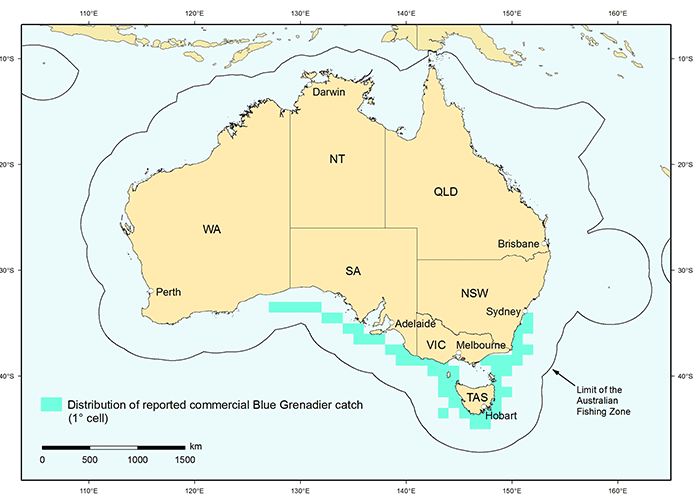Blue grenadier is a bluish silver colour with dark blue fins. It has a long, slender cod-like body with tiny scales.
Blue grenadier has a delicate, sweet, flavour, with moist flesh that flakes easily. It is most suited to frying or baking because of the low oiliness of the species, but it is also excellent for grilling or barbecuing.
Download our species guide on common species caught in AFMA managed fisheries.
Catch limits
| Catch limit | Fishing Mortality* | Biomass** |
|---|---|---|
Catch limit 17,084 tonnes For the 2025–26 Season | G;Not subject to overfishing | G;Not overfished |
* Fishing mortality status relates to the level of fishing pressure on a stock - specifically, whether fishing mortality in the year being assessed is likely to result in the stock becoming overfished or prevent the stock from rebuilding from an overfished state. If fishing mortality exceeds either of these thresholds, a stock is considered to be subject to overfishing.
** Biomass status relates to how many fish there are - specifically, whether the biomass in the year being assessed is above the level at which the risk to the stock is considered to be unacceptable. The HSP defines this level as the limit reference point, below which the stock is considered to be overfished.
Scientific name: Macruronus novaezelandiae
Family: Merlucciidae
Other names: Hoki, blue hake, whiptail
Description: Blue grenadier is a very elongate, compressed fish with a tapering tail. The dorsal and anal fins merge into the tail fin. They have bluish silver backs, silvery belly, and dark blue fins. Blue grenadier have a large mouth and tiny scales.
Size (length and weight): Up to 1.2 metres in length and 6 kg. Commonly found at 0.6‑1 metre in length and 1‑3.5 kg. Females grow slower but become larger than males.
Life span: Up to 25 years. Females live longer than males.
Habitat: Blue grenadier are a deepwater species that occurs on the continental slope. They can be found at depths of 200‑700 metres. Juveniles often occur in shallower bays and inlets. Blue grenadier aggregate near the sea bed during the day and move up into the water column at night.
Prey: Other fish (particularly lanternfish), squids and crustaceans.
Predators: Pink ling.
Reproduction: Most blue grenadier reach reproductive maturity at 4-7 years of age. Spawning occurs in winter and early spring. The main spawning ground for blue grenadier is on the west coast of Tasmania. Females release about 1 million eggs in a single spawning event.
| Fishery found in | Gear used | Catch of this species is targeted or incidental |
|---|---|---|
| Southern and Eastern Scalefish and Shark Fishery – South East Trawl Sector | Bottom trawl | Targeted |
| Southern and Eastern Scalefish and Shark Fishery – South East Trawl Winter Sector | Bottom and midwater trawl | Targeted |
| Southern and Eastern Scalefish and Shark Fishery – Gillnet, Hook and Trap Sector | Longline and dropline | Incidental |
| Southern and Eastern Scalefish and Shark Fishery – Great Australian Bight Trawl Sector | Bottom trawl | Incidental |
The Commonwealth catch of blue grenadier is managed by:
- quota (restricted by weight)
- the number of boats allowed to fish
- the area open to fishing
- gear type and amount.
Commercial fishermen are required to fill in records of their catches, during each fishing trip and when they land their catch in a port. This helps us keep records of how much is being caught.
AFMA decide on the amount that can be caught each year from expert advice and recommendations from fisheries managers, industry members, scientist and researchers.
Blue grenadier is a deepwater fish but migrates into the water column during the night. Adults are found on the continental slope in depths of 200-700 metres, and juveniles in southern Tasmanian bays and inlets.
Blue grenadier is found in New South Wales, Victoria, Tasmania, South Australia and southern Western Australia however they are mainly caught off western and eastern Tasmania.
The majority of blue grenadier catches come from western Tasmanian waters during the winter.

Sometimes fishing interactions may take place with seabirds. To try and reduce these interactions, it is mandatory for all trawl boats in the fishery catching blue grenadier to apply a vessel specific seabird management plan.
To protected seals and dolphins, freezer trawl boats are required to use seal exclusion devices.
Bottom trawl gear can sometimes impact bycatch species and habitats. Management arrangements and strategies to reduce the impact of fishing on the environment include:
- a minimum mesh size for bottom trawls to reduce the catch of small and juvenile fish
- mitigation devices to reduce interactions with threatened endangered and protected species
- area closures to protect vulnerable species and habitats.
Gear
Want to know more?
This is just an overview of blue grenadier, if you want to know more see the links below.
This fish is managed under the Southern and Eastern Scalefish and Shark Fishery.
- See the most recent Fishery status report
- Download raw data on annual catches from AFMA catch disposal records and AFMA daily fishing logbooks
- South East Management Advisory Committee
- Bycatch and discard program
- Visit the FRDC Fishfiles website for the best cooking techniques and recipes for this fish